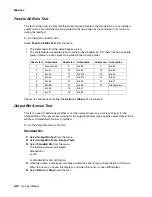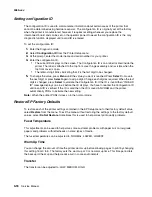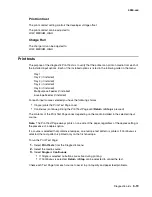
Diagnostic aids
3-21
4060-
xxx
Theory
Autocompensator operation
The autocompensator is a paper pick device that generates its own normal force. This force
generation is inherent in the fundamental design of the pick arm. If light media is used, it picks very
gently. If a heavy media is used, it picks very aggressively. No customer adjustments are necessary,
therefore no special trays are needed for card stock or labels. The gearing in the arm is designed so
the input torque from the motor produces a movement about the pivot of the arm. This movement
produces a downward force at the pick rolls. The friction between the pick roll and the paper
produces a frictional locking condition. If the paper is physically held and not allowed to feed, then
the motor stalls. Slippage between the roll and the paper is theoretically impossible. When the motor
is energized, the pick rolls are driven down into the stack, increasing the normal force and drive force
until the bending strength of the paper is overcome and the paper bends and moves up the dam.
Once this critical threshold is achieved, the normal force remains at a level just high enough to
reliably feed the paper. Rather than having a fixed spring force for feeding all weights of paper like
the D-roll, this device has its own mechanical logic for producing only enough pick energy to feed a
single sheet of paper regardless of its stiffness. High normal force is one of the most significant
contributors to double feeding paper. The pick arm is counterbalanced by an extension spring
located on the pick arm to reduce weight in the rest state. This spring is factory set to exert no more
than ten to fifteen grams on the stack. This is as light as can be realistically set and always guarantee
there is some force to start the autocompensating phenomena. This spring is not to be considered an
adjustment for feeding problems unless it is obvious that the pick arm cannot fall all the way down to
the bottom of the tray or has come loose. Poor gear efficiency can cause the arm to generate higher
normal forces. If the pick assembly is noisy, replacement may be required. The arm must pivot freely
through its full range of motion. On 500-sheet trays there are wrap springs located on the pivot
arbors of the arm. These springs help prevent the arm from bouncing. If the arm appears to be
binding or sticky near the bottom of the tray, these springs may be the problem. Reducing the tension
on the counterbalance spring may be used as a temporary fix to get additional weight at the bottom,
until the pick assembly can be replaced. However, the counterbalance spring is not to be considered
an adjustment for feeding problems.
Autoconnect system, paper tray options, envelope feeder—electrical
Autoconnect cabling and connectors
The printer options make electrical connection automatically, requiring no external cables when the
option is mechanically installed under the printer. Communication between the option and the base
printer stops when you remove an option. The printer no longer recognizes the option and deletes
associated messages. Each installed option below the base printer provides an electrical
autoconnect to the option attached below it. We do not recommend to attach or “Hot Plug” any
options with the base printer power turned on.
Summary of Contents for T63 Series
Page 13: ...Laser notices xiii 4060 xxx Japanese Laser Notice ...
Page 14: ...xiv Service Manual 4060 xxx Korean Laser Notice ...
Page 34: ...1 16 Service Manual 4060 xxx ...
Page 218: ...4 64 Service Manual 4060 xxx ...
Page 236: ...6 2 Service Manual 4060 xxx ...
Page 238: ...7 2 Service Manual 4060 xxx Assembly 1 Covers ...
Page 240: ...7 4 Service Manual 4060 xxx Assembly 2 Frame 1 5 2 1 3 4 3 4 8 6 7 ...
Page 252: ...7 16 Service Manual 4060 xxx Assembly 9 Paper feed alignment 3 2 1 4 ...
Page 258: ...7 22 Service Manual 4060 xxx Assembly 12 Drives Main drive and developer drive 3 2 4 1 7 6 5 ...
Page 260: ...7 24 Service Manual 4060 xxx Assembly 13 Hot roll fuser 3 7 5 2 6 4 1 5 8 7 9 ...
Page 262: ...7 26 Service Manual 4060 xxx Assembly 14 Transfer charging 3 2 4 1 5 6 7 9 10 8 ...
Page 264: ...7 28 Service Manual 4060 xxx Assembly 15 Electronics power supplies 3 7 5 2 6 4 1 ...
Page 266: ...7 30 Service Manual 4060 xxx Assembly 16 Electronics card assemblies 3 1 4 5 6 9 2 4 7 8 10 ...
Page 268: ...7 32 Service Manual 4060 xxx Assembly 17 Electronics shields ...
Page 270: ...7 34 Service Manual 4060 xxx Assembly 18 Cabling diagrams 1 3 1 2 4 5 6 7 8 7 4 ...
Page 272: ...7 36 Service Manual 4060 xxx Assembly 19 Cabling diagrams 2 HVPS LVPS 3 5 4 1 2 6 ...
Page 276: ...7 40 Service Manual 4060 xxx Assembly 21 250 sheet paper tray ...
Page 284: ...7 48 Service Manual 4060 xxx Assembly 23 Duplex option 1 ...
Page 286: ...7 50 Service Manual 4060 xxx Assembly 24 Envelope feeder 3 11 7 13 5 9 2 10 6 4 12 8 14 1 ...
Page 288: ...7 52 Service Manual 4060 xxx Assembly 25 Output expander ...
Page 290: ...7 54 Service Manual 4060 xxx Assembly 25 cont Output expander ...
Page 292: ...7 56 Service Manual 4060 xxx Assembly 26 High capacity output expander ...
Page 296: ...7 60 Service Manual 4060 xxx Assembly 27 5 bin mailbox ...
Page 298: ...7 62 Service Manual 4060 xxx Assembly 27 cont 5 bin mailbox ...
Page 300: ...7 64 Service Manual 4060 xxx Assembly 28 High capacity feeder 1 ...
Page 320: ...7 84 Service Manual 4060 xxx Assembly 38 StapleSmart finisher 4 1 ...
Page 344: ...I 20 Service Manual 4060 xxx ...
Page 345: ......
















































